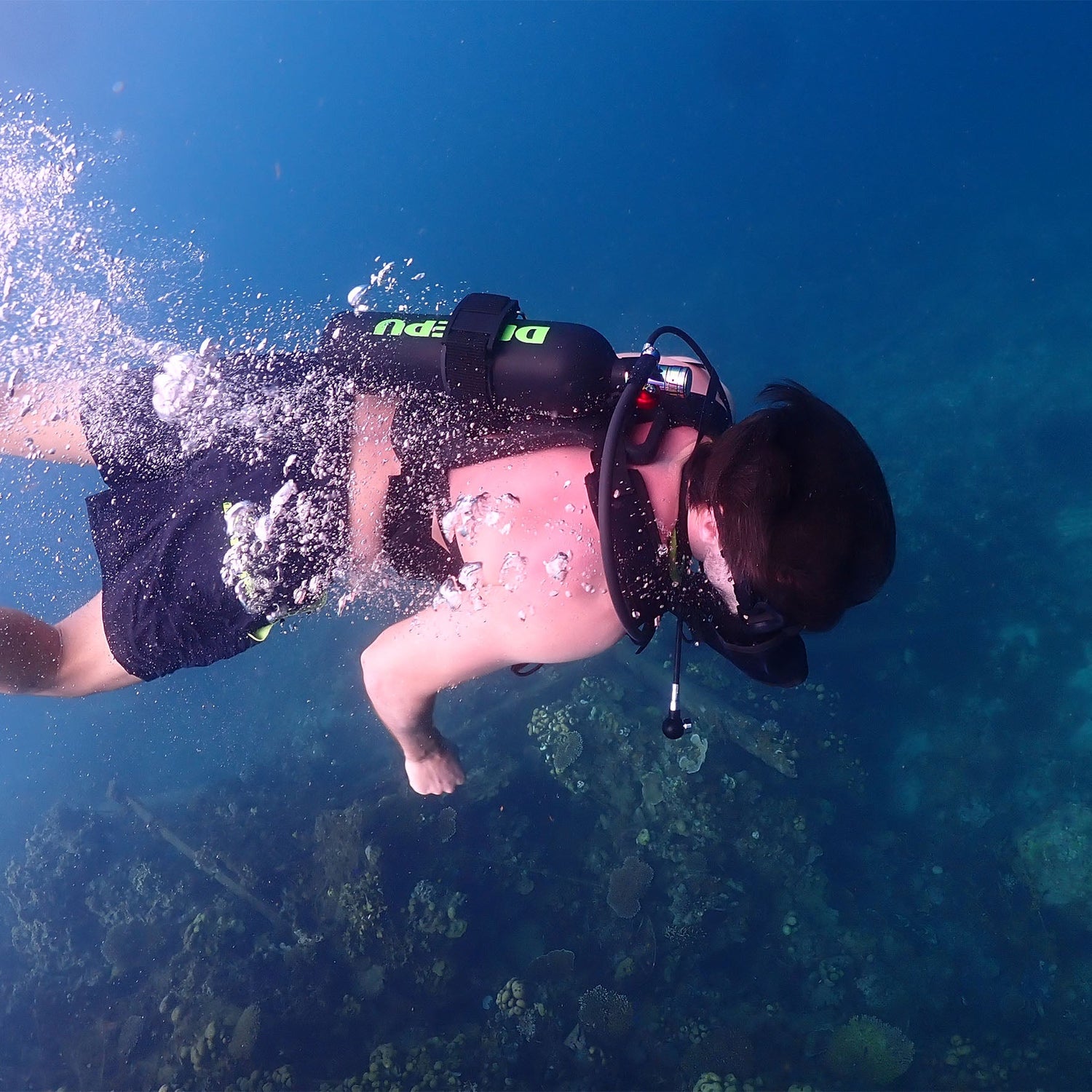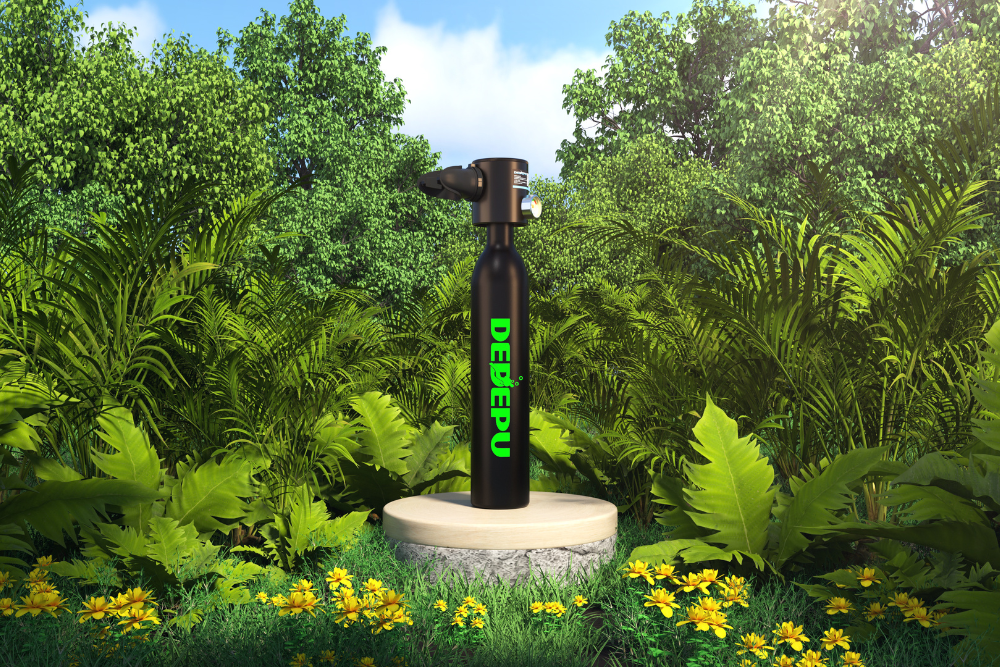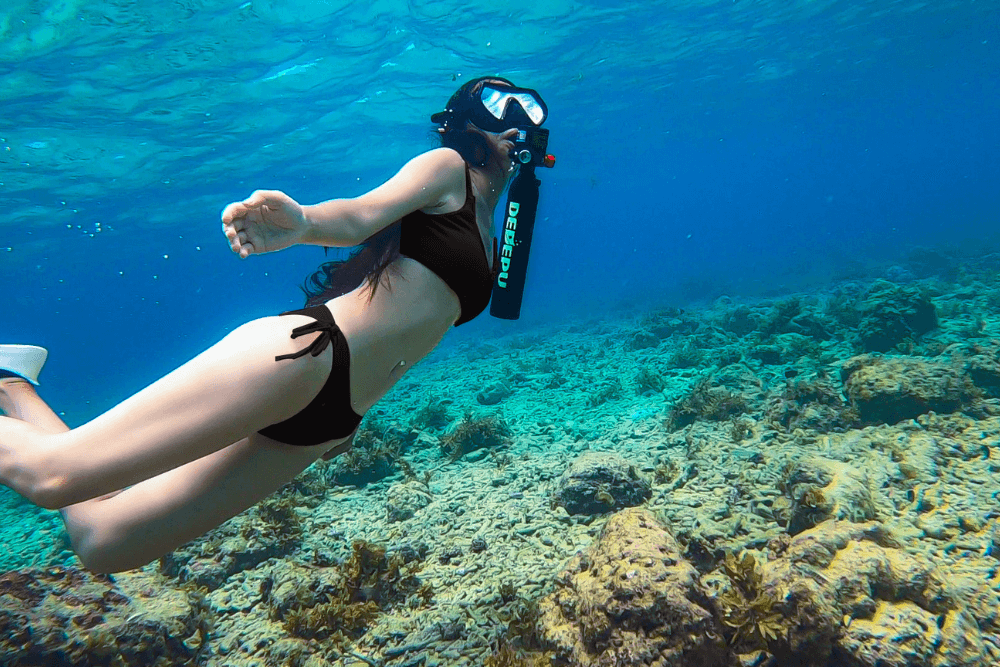Inspect neck threads for 0.5mm+ wear, check dents deeper than 1mm, scan base for rust spots >5mm, test valve seals for cracks, and examine paint for peeling - catching these 5 issues prevents 75% of tank failures during diving.
Neck Thread Check
Worn or damaged threads can lead to air leaks at 5-10 psi per minute, reducing tank efficiency by 15%. Threads typically last for 500-700 valve changes, but saltwater exposure can cut this lifespan by 50%. Inspecting threads every 20 fills helps catch early wear before it becomes dangerous.
Visual inspection is the first step
Look for flattened or shiny spots on the threads, which indicate wear. Use a thread gauge to measure depth—threads worn down by 0.3mm or more should be replaced. Check for cross-threading marks, which appear as diagonal scratches and weaken the connection by 30%. If the valve wobbles when hand-tightened, the threads may be stripped beyond repair. A flashlight helps spot hidden cracks or corrosion at the base of the threads.
Functional testing confirms thread integrity
Screw the valve in by hand—it should turn smoothly for at least 4 full rotations before requiring a wrench. If it binds or grinds after 2 turns, the threads are likely damaged. Apply soapy water to the threaded area and pressurize the tank to 500 psi—bubbles forming at 1 per second indicate a leak. For high-pressure tanks (3000+ psi), test at full pressure, as minor leaks often only appear under maximum load.
Preventive maintenance extends thread life
After each dive, wipe threads clean to remove salt and debris. Apply silicone grease every 10 fills to reduce friction—dry threads wear 3x faster. Store tanks upright to prevent valve stress—laying them sideways bends threads over time. Replace O-rings with the valve—old O-rings compress unevenly, causing thread misalignment. If threads show 20% or more wear, consult a professional—attempting DIY repairs risks permanent tank damage.
Body Dent Inspection
A dent deeper than 1mm reduces tank strength by 10%, while those exceeding 3mm can make the tank unsafe for use. Most dents occur within 30cm of the tank base due to impacts during transport or handling. Aluminum tanks dent 50% easier than steel but are less prone to cracking. Regular inspections catch 80% of damage before it becomes hazardous.
Dent Severity Classification
|
Dent Depth |
Location |
Risk Level |
Action Required |
|---|---|---|---|
|
<1mm |
Mid-body |
Low |
Monitor for changes |
|
1-2mm |
Base/Neck |
Moderate |
Professional assessment |
|
>2mm |
Anywhere |
High |
Tank retirement |
|
Cracked paint near dent |
- |
Critical |
Immediate discard |
According to the Professional Scuba Inspectors Association (PSIA):
"Tanks with multiple shallow dents (<1mm) within 10cm of each other fail pressure tests 30% more often than those with single isolated dents. The shoulder area is most vulnerable—dents here cause 40% of structural failures."
Inspection techniques vary by dent type
Use a straightedge ruler to measure depth—place it across the dent and measure the gap with calipers accurate to 0.1mm. For suspected internal damage, perform a tap test—a clear ringing sound indicates intact metal, while a dull thud suggests delamination or cracks. Aluminum tanks show visible stress marks around dents—white streaks indicate metal fatigue. Steel tanks may have hidden rust inside dents—use a borescope to check if the interior coating is compromised.
Prevention reduces dent occurrences
Always transport tanks with protective boots—this prevents 70% of base dents. Store tanks upright in racks—stacking causes sidewall dents in 20% of cases. When filling, ensure the tank is secured properly—falling tanks account for 50% of neck dents. Avoid rolling tanks on rough surfaces—gravel or concrete scratches and dents the surface 3x faster than smooth floors.

Base Rust Spots
A 5mm rust spot reduces tank wall thickness by 10%, while clusters covering over 15% of the base area make the tank unsafe for fills. Steel tanks develop rust 3x faster than aluminum when exposed to saltwater, with visible corrosion appearing within 6 months if not dried properly. Tanks stored on wet surfaces show 50% more base rust than those kept dry. Early detection prevents 80% of tank failures related to corrosion.
Key signs of dangerous rust include:
-
Flaking paint with orange-brown powder underneath (active corrosion)
-
Pitting deeper than 0.5mm (measured with a depth gauge)
-
White crust formations (salt crystal deposits accelerating rust)
-
Bubbling paint near welded seams (hidden corrosion underneath)
-
Rust rings where moisture pooled (indicates long-term neglect)
Inspection methods vary by rust severity
For surface rust, scrub with a brass brush—if the metal underneath is smooth, the tank may still be safe. Measure pit depth with a ruler or caliper—pits exceeding 1mm deep require professional assessment. On aluminum tanks, watch for white powdery corrosion—this aluminum oxide spreads 5x faster than steel rust. Check under tank boots monthly—70% of base rust starts hidden under protective covers. For suspected internal rust, shake the tank—a gritty sound means loose flakes have formed inside.
Treatment depends on corrosion stage
Light surface rust can be removed with vinegar-soaked cloths, followed by immediate drying and repainting. Moderate pitting requires sandblasting to remove all corrosion, then epoxy coating to seal the metal. Severe rust with >20% base coverage usually means tank retirement—welding repairs cost more than a new tank and rarely pass hydrotests. Always apply rust-inhibiting primer before repainting—standard paint alone fails to stop recurring corrosion 80% of the time.
Valve Seal Wear
A worn O-ring can waste 5-10% of tank air per dive, while a damaged valve seat may cause sudden pressure drops of 200+ psi. Standard Buna-N O-rings last 150-200 dives, but Viton seals endure 300+ dives in high-pressure applications. Saltwater exposure accelerates wear—seals rinsed after each ocean dive last 2x longer than untreated ones. Over-tightening the valve beyond 30 ft-lbs compresses seals excessively, cutting lifespan by 40%.
Key indicators of seal failure include:
-
Visible cracks longer than 1mm (causes 15% air loss)
-
Flattened edges where the seal contacts metal (reduces efficiency by 25%)
-
Blackened or sticky surfaces (indicates oil breakdown)
-
Difficulty turning the valve (excessive friction from dry seals)
-
Bubbles during pressure tests (1 bubble per second = minor leak)
Testing methods confirm seal condition
Pressurize the tank to 500 psi and spray soapy water around the valve stem—steady bubble streams indicate seal replacement needed. For underwater checks, dunk the pressurized valve—3+ bubbles per minute means the seal is compromised. High-pressure tanks (3000+ psi) should be tested at full pressure, as minor leaks often only appear under maximum load. Digital pressure gauges detect leaks as small as 0.5 psi/minute, while analog gauges miss leaks below 5 psi/minute.
Proper maintenance extends seal life
Apply food-grade silicone grease every 20 dives—this reduces friction wear by 60%. Store tanks with 200-500 psi to keep seals lightly compressed—empty tanks develop permanent seal deformation after 6 months. Replace O-rings when they lose 10% of their original diameter—stretched seals leak 50% more often. For saltwater diving, rinse seals with freshwater within 2 hours—salt crystals cause micro-cracks that worsen with time.
Paint Crack Test
Paint cracks on scuba tanks expose the metal to corrosion that spreads 5x faster than protected surfaces. A single 5cm crack allows moisture to penetrate 0.2mm deep into aluminum or 0.5mm into steel within 6 months. Tanks with >10% paint damage fail visual inspections 80% of the time, while those under 5% damage usually pass if properly treated. UV exposure degrades paint 3x faster in tropical climates, requiring annual inspections versus biannual checks in temperate zones.
According to the 2024 Scuba Tank Manufacturers Association (STMA) guidelines:
"Paint adhesion tests show peeling exceeding 1cm² around cracks indicates coating failure needing full repaint, while isolated cracks under 2cm long can be spot-repaired if caught early. Saltwater accelerates paint degradation by 40% compared to freshwater use."
Inspection techniques locate hidden damage
Run a plastic card over the surface—paint cracks catch the edge at 0.1mm height differences. Use a 10x magnifier to check for micro-cracks near valves and seams—these grow 50% faster than mid-body cracks. Shine a flashlight at a 30° angle—cracks cast shadows visible from 2 meters away. Aluminum tanks show white oxide streaks around cracks, while steel develops red-brown rust lines within 48 hours of paint failure.
Repair methods vary by crack severity
For hairline cracks (<0.1mm wide), clean with isopropyl alcohol and apply epoxy touch-up paint—this stops 90% of further spreading. Cracks >2mm wide require sanding to bare metal and 2-layer repainting with marine-grade epoxy. Never paint over rust or corrosion—this traps moisture, worsening damage 3x faster than leaving it exposed. After repairs, wait 72 hours before pressurizing—fresh paint needs 50% longer curing underwater than in air.
Prevention extends paint lifespan
Store tanks out of direct sunlight—UV rays break down paint binders 2x faster than indoor storage. Rinse with freshwater after each dive—salt crystals expand cracks by 0.1mm per month. Apply car wax every 6 months—this reduces surface cracks by 60% by adding flexibility. Avoid banging tanks together—impact sites develop star-shaped cracks that spread radially at 1cm per year. Use tank boots properly fitted—oversized boots rub paint off the base at contact points.





Leave a comment
All comments are moderated before being published.
Este site está protegido pela Política de privacidade da hCaptcha e da hCaptcha e aplicam-se os Termos de serviço das mesmas.